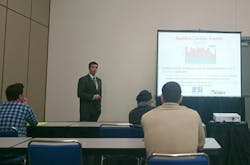FHWorld16: Leading Health Risks on the Modern Fireground
It won’t be surprising to most firefighters that cardiovascular events and chemical exposure leading to cancer are two leading health risks on the modern fireground. What they may not know, however, are the more specific details of how different firefighting tactics or techniques can impact the levels of exertion or exposure. This is what Gavin Horn and Denise Smith discussed in their Tuesday Firehouse World session “Firefighters’ Leading Health Risks on the Modern Fireground.”
In order to better quantify some of these potentially nebulous topics, Horn, the director of research at the University of Illinois Fire Service Institute (IFSI), and Smith, a professor for health and exertion sciences at Skidmore College, discussed the release of a recent IFSI study, which can be found here. The study was part of a partnership and collaboration among IFSI, UL Firefighter Safety Research Institute, NIOSH, Globe Manufacturing, and the Department of Homeland Security - FEMA Assistance to Firefighters Grants Program.
Horn and Smith explained the study’s methodology and how they were able to recreate virtually every aspect of firefighting in a way that was safe and still allow researchers to capture essential data. Some of the factors involved in the study include tactics (traditional interior vs. transitional attack), firefighting location (interior, overhaul, command), firefighter hygiene (skin cleaning, decon). According to the study, the goal is to inform the next steps in research and, more importantly, help the firefighting profession better protect its most important resource— the firefighter.
Chemical Exposure/Carcinogens
Horn stated that an alarming the number of firefighters die as a result of cancer these days. He cited previous research indicating that firefighters are at an increased risk of certain cancers in particular, including digestive, oral, pharyngeal, laryngeal and mesothelioma.
Using modern building materials and room contents, and employing real firefighters executing commonly employed tactics, the IFSI study looked at the products of combustion, specifically toxic gas and particulate production, particulates/chemicals on PPE and dermal exposure. Chemical exposure measures focused on what chemicals were in the air, how air concentrations varied by job assignment and location, what chemicals got on firefighters’ skin and PPE, and how effective decontamination practices were at eliminating exposure. Area air sampling included within the structure, downwind of the structure and near the pump operator.
Measurements of cardiovascular function (hemostatic balance, ECG, autonomic function) were obtained before, immediately post-firefighting activity, and after 2 or 12 hours of recovery. The key was to evaluate firefighters’ occupational exposure to carcinogens, including effects of different suppression tactics and how turnout gear contamination and off-gassing contribute to continued exposure.
Horn explained that one takeaway is that decontamination of gear with a rise does a good job reducing firefighters’ exposure to carcinogens. Additionally, even putting gear outside in an open area and allowing it to off-gas significantly reduced the level of volatile organic compounds (VOCs).
The study offers several recommendations related to minimizing the inhalation of contaminants during a fire response:
- Wear SCBA during knockdown, overhaul and other firefighting activities where exposure to combustion byproducts is likely. This includes when walking through the smoke plume during the sizing up of the fire or when making openings to ventilate the structure.
- Remain upwind of fires if not directly involved in the fire attack. If this cannot be accomplished, SCBA should be worn. Fire personnel should also remain upwind of diesel exhaust emitted from the apparatus
To minimize inhalation of contaminants off-gassing from contaminated gear:
- Doff gear before entering the rehab area.
- Do not store or wear contaminated turnout gear inside the apparatus during the ride back to the station.
- Do not store gear in personal vehicles or living areas.
To minimize skin absorption of contaminants during (or after) a fire response:
- Decontaminate and/or launder turnout gear, fire hoods and other equipment that readily contact the skin after each fire response. Do not take gear or other equipment home.
- Wash hands and neck skin immediately and shower as soon as possible after a fire response.
Cardiovascular Events
Horn indicated that firefighting is associated with a 10-100 percent greater risk of suffering a cardiac event compared to non-firefighting duties. What’s more, he said, is that the available data suggests that there are 20-25 non-fatal cardiac events in the line of duty for every single fatality. Smith later posed the question, “What is it about firefighting that causes some firefighters to have a sudden cardiac event?” She acknowledged that several factors are involved, including heat, strain, dehydration, inhaling smoke and the products of combustion, and that several studied have addressed these issues in the past. What’s different with this study, she said, is the realistic environment in which it was conducted.
The IFSI study looked at environmental temperature, PPE temperature, and skin care and core temperature. Measurements of toxic exposure (metabolites in blood, breath and urine) were obtained to assess participants’ level of risk on the scene of an incident, within one hour of an incident and within 24 hours of an incident, for example.
Some interesting findings related to the variations in core temperature during specific fireground acts—interior operations, exterior operation, command functions and overhaul activities. One might expect the interior firefighting to show the highest core temperature levels, she said, but it was actually overhaul activities. “This type of heavy work traps muscular heat,” she explained. Additionally, results showed less heat stress during a transitional attack than during traditional interior attack.
Smith also explained that, “firefighting is a powerful stimulant to increase blood clotting.” But what activities increase the levels of coagulation? Compared to command activities, where there was not a real change in coagulation activities, interior operations had increased coagulation levels. There was some increase in coagulation with overhaul activities, but the largest increase in coagulation levels occurred during outside ventilation activities.
The report offers several recommendations to minimize cardiovascular strain associated with fire response and decrease the risk of a sudden cardiac event:
- Ensure that all firefighters have received a proper medical evaluation consistent with NFPA 1582 guidelines and performed by a physician familiar with the physiological demands of firefighting, and that cardiovascular risk factors, if present, are being aggressively treated.
- Utilize incident scene rehabilitation to provide rest, hydration and cooling, and medically monitor firefighters for signs and symptoms of heat-related illness or cardiovascular events.
- Ensure that all firefighters are physically fit so that they can meet the physical demands of the job and so that they can do so with
According to the report, “The vast dataset that has been collected during this study is undergoing rigorous scrutiny to clean up any incorrect parameters, combine data sets and statistically analyze the outcomes. … After the entire analysis has been completed, we will be able to provide detailed recommendations and tactical considerations.”
Making Changes
At the conclusion of the session, some attendees noted changes they would make to reduce their risks. One indicated that he planned to clean his hood more often. Other attendees pondered how to impact fire service culture in order to see real behavioral changes among firefighters. It’s certainly a complicated question—and one that Firehouse takes very seriously. Firehouse has recently added a research column to the magazine, as well as fitness, nutrition and behavioral health columns to help reinforce health and wellness initiatives.
For more findings and recommendations from the IFSI study, the full report can be found here.
More from Firehouse World 2016
- Photos: Day 1 - Future Firefighter Program
- FHWorld16: Firehouse Ambassadors Get Lessons in Values
- FHWorld16: Fireground Air Management - A US/UK Perspective
- FHWorld16: Building a Robust Fire Dynamics Training Program
- FHWorld16: The Halligan Is a Valuable Tool on the Fireground
- FHWorld16: Sendelbach Poses Challenge to Fire Service
- FHWorld16: Chief Hood Says It's 'Time to Own It'

Janelle Foskett
Janelle Foskett served as editorial director of Firehouse Magazine and Firehouse.com, overseeing the editorial operations for the print edition along with working closely with the Web team.






